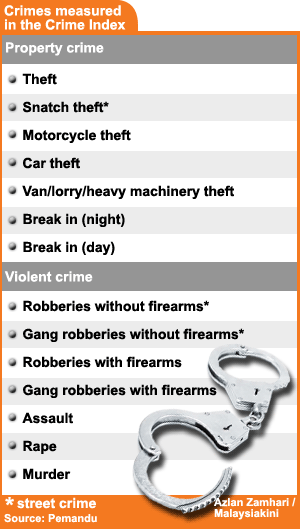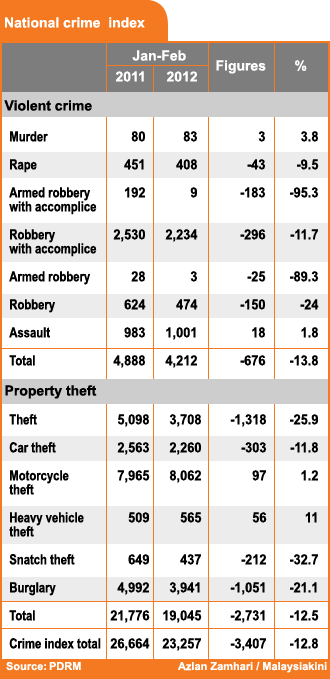SPECIAL REPORT Ye Choh Wah has stopped taking his five-minute walk to his favourite mamak stall. Nowadays, if he wants his fix of teh tarik after sunset, he gets into his car and drives there.
"It's safer," Ye said when met at his home in Puchong, Selangor, earlier this week.
 In the past five years, Ye's
(left)
home of 17 years has been broken into, his mother's home in Johor Bahru broken into twice, while two of his brothers-in-law, who live in Klang, suffered the same act of crime.
In the past five years, Ye's
(left)
home of 17 years has been broken into, his mother's home in Johor Bahru broken into twice, while two of his brothers-in-law, who live in Klang, suffered the same act of crime.
"It was in the morning, in daylight. (My brother-in-law) was in the toilet when he heard some noise.
"He opened the door and there was a stranger in the house. He quickly closed the toilet door and the burglar left," he said.
"I'm not very special. Everyone has their story to tell. It's not just an isolated case, that I'm unlucky, that I never watch my back, that I'm careless, not alert. That's not the case. My house has alarms. It's well protected."
 Having worked and studied in New York City in the 1980s, at the height of the crime scourge there, Choh claims he felt safer in the American city than he does in Malaysia today.
Having worked and studied in New York City in the 1980s, at the height of the crime scourge there, Choh claims he felt safer in the American city than he does in Malaysia today.
As a family man, the father of two never ventures to places that he considers unsafe but this does not make him feel safer - "they are now coming to you".
Later, walking down his street in the leafy upper middle-class Bandar Kinrara, he points to a string of houses that have been broken into. Other neighbours were victims of snatch theft - one of whom, he said, suffered a concussion.
A parang to the neck
One neighbour, he said, came back from the market one morning and when she got out of the car, "a parang was put to her neck".
Choh's neighbour, Edmund Chang, now makes sure to check his surroundings before he gets out of his car after work.
Last year, his house was broken into and his wife watched in a state of panic as the thief sauntered out of their home with his laptop, his son's wallet and mobile phone.
"It was 6.30am. He shone a flashlight at my face, but I thought it was my son playing the fool so I didn't get up. If I did, would I have got stabbed? It scared the sh** out of me," he said.
 Ironically, just last week, the Puchong police station was given RM80,000 for coming out tops in a competition among more than 400 police stations in terms of efforts taken to bring down crime and crime rates in the locality.
Ironically, just last week, the Puchong police station was given RM80,000 for coming out tops in a competition among more than 400 police stations in terms of efforts taken to bring down crime and crime rates in the locality.
The competition is among the several initiatives under the National Key Results Area (NKRA) for crime reduction, spearheaded by the Performance and Management Delivery Unit (Pemandu).
Since 2009, Pemandu has introduced the safe city programme which includes installing CCTVs and street lights to allay fears of crime and an omnipresence programme that puts more police personnel on the streets.
And the numbers seem to show that it is working.
The crime index - a measurement of police reports lodged for 14 types of property and violent crimes - for the period January to June 2012 had dropped by 26.3 percent compared with the same period in 2009.
Pemandu's fear of crime study also indicates that as of May 2012, about half of Malaysians were still afraid of being victims of crime - an improvement of about four percent since December 2009, but all the same, still a scary figure.
Time lag and trauma
Crime reduction NKRA director Eugene Teh said that the mismatch between crime figures and fear of crime could be explained partly by a time lag.
 "The actual changes on the ground are not immediately followed by changes in perception. In the United Kingdom, when crime went down, it (the perception) did not change for five years.
"The actual changes on the ground are not immediately followed by changes in perception. In the United Kingdom, when crime went down, it (the perception) did not change for five years.
"The fear actually grew because people are talking more about crime and they see more cops on the street," Teh ( left ) said at a media briefing earlier this month.
Criminologist P Sundramoorthy offers a different explanation.
 The USM lecturer with 19 years experience in the area said fear of crime is contributed largely by personal experience of crime, especially if it happens in their comfort zones.
The USM lecturer with 19 years experience in the area said fear of crime is contributed largely by personal experience of crime, especially if it happens in their comfort zones.
"People take crime such as break-ins seriously because this is a violation of a safe haven. It is not a matter of the monetary value of the loss but a violation of the boundary between you and the outside world.
"It creates very negative impressions on people. Trauma from theft cases is high, so although the number of incidents may have dropped, it still draws public perception," Sundramoorthy said.
He said the people also grow more fearful when their loved ones fall prey to criminals.
Chin Xin-Ci, 25, fought her way out of an attempted kidnapping at a parking lot at a shopping centre in Damansara, Selangor, last month.
Horrified by what happened to her, a group of Chin's female friends have started a "grocery shopping group" so that they need not be alone when parking at basement car parks of shopping centres.
 Under therapy and still "weary" about her experience, Chin
(right)
feels that Malaysians have come to a point when they are tired of living under threats of street crime such as smash and grab and snatch theft.
Under therapy and still "weary" about her experience, Chin
(right)
feels that Malaysians have come to a point when they are tired of living under threats of street crime such as smash and grab and snatch theft.
"These are all just too close to home now," she said.
On a personal level, she said what affected her the most was the seemingly uncaring attitude of the authorities, who keep insisting that crime is down.
"What has affected me and the people around me is that not a single policeman or politician has stood up to say that what had happened to these people is really sad and we will not stand for it.
"Safety is everyone's right. Now it feels like nothing has been done and the fear perpetuates," she said.
Fear rises when cops are seen as inefficient
Chin, who has not been able to get through to her investigating officer to check on her case, feels that public perception of the police is at an all time low.
 "Sometimes I feel bad for the police... they are underpaid and overworked and have poor benefits. They can't just be blamed but you ask people on the streets if they trust the police...I have done this with a few people that I meet and they say ‘no'. It's sad."
"Sometimes I feel bad for the police... they are underpaid and overworked and have poor benefits. They can't just be blamed but you ask people on the streets if they trust the police...I have done this with a few people that I meet and they say ‘no'. It's sad."
Police efficiency, said Sundramoorthy, has a big impact on people's perception of crime.
"The job performance (of the police) is important in forming public perception and views. If they perceive police to be not as efficient, they perceive crime rates to be higher," he said.
Ye said that when his house was broken into about four years ago, the police did not even come to his house to collect evidence.
Both he and Chang feel that their neighbourhood would be safer if there were more police patrols.
Sundramoorthy said that at some levels, the escalating fears of Ye and Chang were irrational, but such fears could not be simply dismissed.
 "Comparative analyses with (other developing countries) show that our crime rate is on the lower side. But based on assumption by people, there is a negative perception.
"Comparative analyses with (other developing countries) show that our crime rate is on the lower side. But based on assumption by people, there is a negative perception.
"We need to find out where it is coming from. Many developed nations spend money on victimisation studies. It is a must in civil society," said Sundramoorthy (left) who has 19 years of experience in the field.
He added that Pemandu's study on fear of crime is "professionally not meaningful" as it is not stratified geographically and is not statistically significant enough to reflect the whole nation.
At just above 50 percent, Sundramoorthy said, Pemandu's fear of crime figures may make it look as if fear of crime is "not so serious". However, the true levels are yet to be seen.
Until a nationwide, continuous study is conducted, he said, criminologists and policy makers would be hard pressed to truly say why the nation remains so afraid and how to address this fear effectively.
Part 2: Is fear of crime going viral through social media?
Part 3: Guarded communities: Private cost of personal safety
Related stories
Caught on video: Cop pistol whips hotel staff
One in two polled have been hit by crime
IGP defends crime data as accurate
House of Megat Junid's widow broken into

